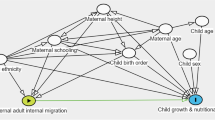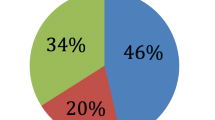Abstract
Internal migration is a salient dimension of adulthood in Haiti, particularly among women. Despite the high prevalence of migration in Haiti, it remains unknown whether Haitian women’s diverse patterns of migration influence their children’s health and survival. In this paper, we introduce the concept of lateral (i.e., rural-to-rural, urban-to-urban) versus nonlateral (i.e., rural-to-urban, urban-to-rural) migration to describe how some patterns of mothers’ internal migration may be associated with particularly high mortality among children. We use the 2006 Haitian Demographic and Health Survey to estimate a series of discrete-time hazard models among 7,409 rural children and 3,864 urban children. We find that compared with their peers with nonmigrant mothers, children born to lateral migrants generally experience lower mortality, whereas those born to nonlateral migrants generally experience higher mortality. Although there are important distinctions across Haiti’s rural and urban contexts, these associations remain net of socioeconomic factors, suggesting they are not entirely attributable to migrant selection. Considering the timing of maternal migration uncovers even more variation in the child health implications of maternal migration; however, the results counter the standard disruption and adaptation perspective. Although future work is needed to identify the processes underlying the differential risk of child mortality across lateral versus nonlateral migrants, the study demonstrates that looking beyond rural-to-urban migration and considering the timing of maternal migration can provide a fuller, more complex understanding of migration’s association with child health.
Similar content being viewed by others
Notes
The cross-sectional nature of the data prohibits us from accounting for change in household characteristics between the time of the survey and the child’s birth or, in the case of deceased children, death. We reduce the risk of misclassification by limiting the analyses to births that occurred in the 10 years before the survey. Furthermore, in ancillary analyses we further restrict the sample to births that occurred less than seven years before the survey and confirm that the results are consistent with those shown here.
We classify mothers’ origin community as “urban” if she migrated from a city or town and “rural” if she migrated from the countryside.
In supplemental models (results available upon request), we also categorize these children according to their mother’s destination residence and confirm that, because of the small percentage of cases, the classification of these children does not influence the results.
In both rural and urban Haiti, mortality is significantly higher in the first month of life and then drops throughout the remainder of the first five years. There is a nominal increase in mortality in later childhood in the rural sample, which likely is evidence of age heaping. As discussed in the methods section, our discrete-time modeling approach is ideal for handling the age heaping that is a common feature of retrospective mortality data.
References
Ahlers, T. H. (1978). Haitian rural–urban migration: A case study of four small towns: Bib. Orton IICA/CATIE.
Alscher, S. (2011). Environmental degradation and migration on Hispaniola Island. International Migration, 49, e164–e188.
Bilsborrow, R. E. (1992). Preliminary report of the United Nations Expert Group Meeting on the feminization of internal migration. International Migration Review, 26, 138–161.
Bollen, K. A., Glanville, J. L., & Stecklov, G. (2007). Socio-economic status, permanent income, and fertility: A latent-variable approach. Population Studies, 61, 15–34.
Brockerhoff, M. (1990). Rural-to-urban migration and child survival in Senegal. Demography, 27, 601–616.
Brockerhoff, M. (1994). The impact of rural-urban migration on child survival. Health Transition Review, 4, 127–149.
Brockerhoff, M. (1995). Child survival in big cities: The disadvantages of migrants. Social Science and Medicine, 40, 1371–1383.
Brockerhoff, M., & Brennan, E. (1998). The poverty of cities in developing regions. Population and development Review, 24(1), 75–114.
Byerlee, D. & Eicher, C. K. (1972). Rural employment, migration, and economic development: Theoretical issues and empirical evidence from Africa. Africa Rural Employment Paper No. 1.
Cayemittes, M., Placide, M. F., Mariko, S., Barrère, B., Sévère, B., & Alexandre, C. (2007). Enquête Mortalité, Morbidité et Utilisation des Services, Haïti, 2005–2006. Calverton, Maryland, USA: Ministère de la Santé Publique et de la Population, Institut Haïtien de l’Enfance et Macro International Inc.
Charmes, J. (2000). Indicateurs Sociaux et Suivi des Conditions de Vie des Me′nages en Haı¨ti: Rapport D’Etape. UNDP Mission in Haiti.
Cleland, J. G., & Van Ginneken, J. K. (1988). Maternal education and child survival in developing countries: the search for pathways of influence. Social science and medicine, 27, 1357–1368.
Collinson, M., Tollman, S. M., Kahn, K., Clark, S., & Garenne, M. (2006). Highly prevalent circular migration: households, mobility and economic status in rural South Africa. In M. Tienda, S. Findley, S. Tollman, & E. Preston-Whyte (Eds.), Africa on the move: African migration and urbanisation in comparative perspective (pp. 194–216). Johannesburg: Wits University Press.
Farmer, P., Léandre, F., Mukherjee, J. S., Claude, M., Nevil, P., Smith-Fawzi, M. C., et al. (2001). Community-based approaches to HIV treatment in resource-poor settings. Lancet, 358, 404–409.
Gage, A. J., & Guirlène Calixte, M. (2006). Effects of the physical accessibility of maternal health services on their use in rural Haiti. Population Studies, 60.3, 271–288.
Gammage, S. (2004). Exercising exit, voice and loyalty: A gender perspective on transnationalism in Haiti. Development and Change, 35, 743–771.
Greenwood, M. J. (1997). Internal migration in developed countries. Handbook of Population and Family Economics, 1, 647–720.
Houweling, T. A. J., Kunst, A. E., & Mackenbach, J. P. (2003). Measuring health inequality among children in developing countries: does the choice of the indicator of economic status matter? International Journal for Equity in Health, 2, 8.
Hunter, L. M., Reid-Hresko, J., & Dickinson, T. W. (2011). Environmental change, risky sexual behavior, and the HIV/AIDS pandemic: Linkages through livelihoods in rural Haiti. Population Research and Policy Review, 30, 729–750.
Islam, M., Azad, K., & Abul, K. (2008). Rural–urban migration and child survival in urban Bangladesh: Are the urban migrants and poor disadvantaged? Journal of Biosocial Science, 40, 83–96.
Johnson, S. (2007). Extreme events and Haitian environmental refugees. ICE case studies, American University, Washington, DC.
Kiros, G. E., & White, M. J. (2004). Migration, community context, and child immunization in Ethiopia. Social Science and Medicine, 59, 2603–2616.
Laguerre, M. S. (1998). Diasporic Citizenship: Haitian Americans in Transnational America. New York: St. Martin’s Press.
Lunde, H. (2010). Young Haitian labour migrants: Risks and opportunities in Haiti and in the Dominican Republic. Oslo: Fafo Institute for Labor and Social Research.
Omariba, D., & Boyle, M. H. (2007). Family structure and child mortality in sub Saharan Africa: Cross national effects of polygyny. Journal of Marriage and Family, 69, 528–543.
Omariba, D. W. R., & Boyle, M. H. (2010). Rural–urban migration and cross-national variation in infant mortality in less developed countries. Population Research and Policy Review, 29, 275–296.
Orozco, M. (2006). Understanding the remittance economy in Haiti. World Bank, Washington.
Ssengonzi, R., De Jong, G. F., & Stokes, C. (2002). The effect of female migration on infant and child survival in Uganda. Population Research and Policy Review, 21, 403–431.
Stephenson, R., Matthews, Z., & McDonald, J. W. (2003). The impact of rural–urban migration on under-two mortality in India. Journal of Biosocial Science, 35, 15–31.
Verner, D. (2008). Making Poor Haitians Count. World Bank Policy Research Working Paper, No. 4571, March 2008, World Bank, Washington, DC.
Wang, W. W., & Fan, C. C. (2006). Success or failure: Selectivity and reasons of return migration in Sichuan and Anhui, China. Environment and Planning, 38, 939–958.
Wooding, B., & Petrozziello, A. J. (2013). New challenges for the realisation of migrants’ rights following the Haiti 2010 earthquake: Haitian women on the borderlands. Bulletin of Latin American Research, 32(4), 407–420.
Author information
Authors and Affiliations
Corresponding author
Rights and permissions
About this article
Cite this article
Smith-Greenaway, E., Thomas, K.J.A. Exploring Child Mortality Risks Associated with Diverse Patterns of Maternal Migration in Haiti. Popul Res Policy Rev 33, 873–895 (2014). https://doi.org/10.1007/s11113-014-9326-9
Received:
Accepted:
Published:
Issue Date:
DOI: https://doi.org/10.1007/s11113-014-9326-9




